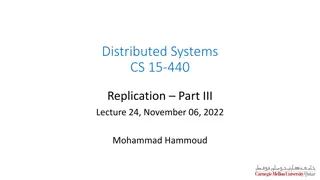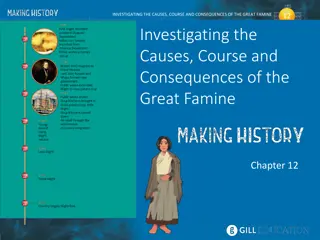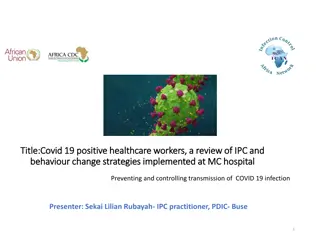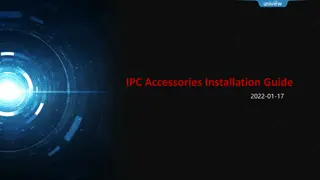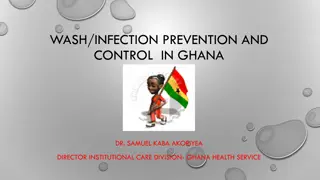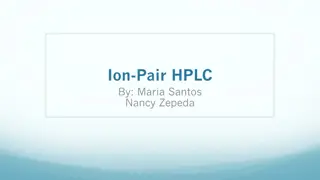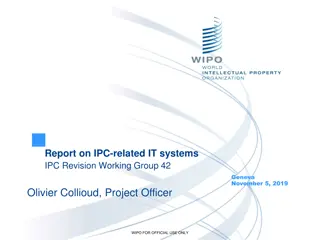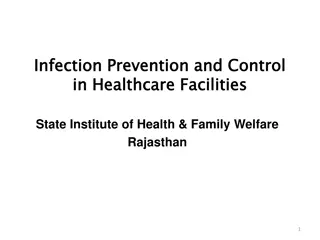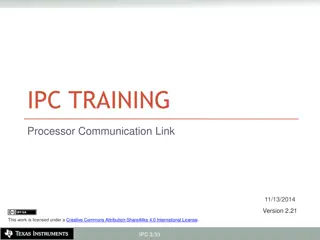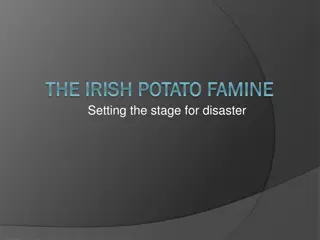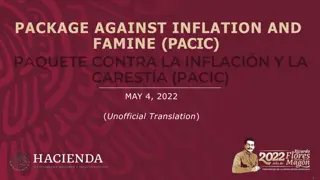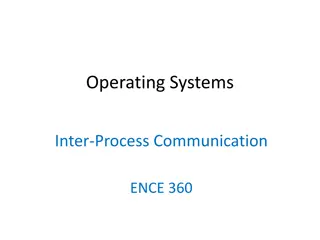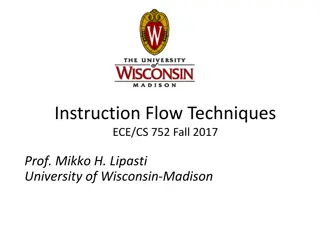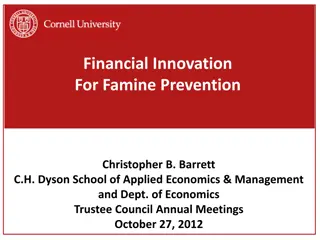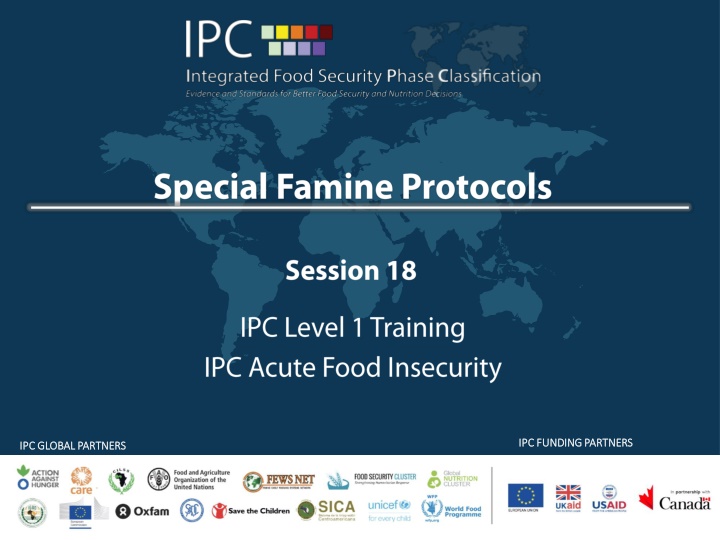
Famine Protocols and Classification Criteria in Crisis Situations
Explore the objective and workings of Famine Protocols in identifying and classifying famine conditions, distinguishing between severe Crisis/Emergency and Famine, and reviewing country experiences with Famine in the past decade.
Download Presentation

Please find below an Image/Link to download the presentation.
The content on the website is provided AS IS for your information and personal use only. It may not be sold, licensed, or shared on other websites without obtaining consent from the author. If you encounter any issues during the download, it is possible that the publisher has removed the file from their server.
You are allowed to download the files provided on this website for personal or commercial use, subject to the condition that they are used lawfully. All files are the property of their respective owners.
The content on the website is provided AS IS for your information and personal use only. It may not be sold, licensed, or shared on other websites without obtaining consent from the author.
E N D
Presentation Transcript
IPC FUNDING PARTNERS IPC FUNDING PARTNERS IPC GLOBAL PARTNERS IPC GLOBAL PARTNERS
Famine: The total failure Famine Def.: For IPC, Famine exists in areas where at least one in five households has or is most likely to have an extreme deprivation of food. Starvation, death, destitution and extremely critical levels of acute malnutrition are or will likely be evident. Significant mortality, directly attributable to outright starvation or to the interaction of malnutrition and disease, is occurring or will likely be occurring. In plenary, discuss What s the difference between a severe Crisis/Emergency and a Famine? Do you know what countries have experienced Famine conditions in the last 10 years?
Famine Protocols What is the objective of the Famine Protocols? To promote an accountable Famine Classification, ensuring highest possible standards of rigour, neutrality and quality of analysis. How do the Special Famine Protocols work? Further to regular protocols specific for Phase 5 Famine classifications only Additional protocols are presented for each Function. This section focuses on an overview - more detailed guidance included in the IPC Guidance Note on Famine and IPC Level 2 trainings. Guidance is limited to Phase 5 Classifications only Whenever IPC analysis might result in classification of Famine, itis crucial that analysts consult the IPC Global Support Unit to clarify the way forward in terms of support and the review process.
Function 1: Famine Protocols Special Protocols include the need for specific experts in the Analysis Team as follows: Nutritionists (mandatory) Communication experts (recommended) Analysts with advanced knowledge of mortality analysis (mandatory) Global and regional experts to support the analysis (recommended)
Function 2: Famine Protocols - Special protocol for evidence requirements for current classification: Strict evidence is required for Famine solid evidence Loose evidence requirements, accompanied by endorsement from the Famine Review Committee (FRC) for Famine reasonable evidence Classifications Famine solid evidence (current) Famine reasonable evidence (current) The three outcomes with R2 direct evidence (i) Food consumption and livelihood change: HDDS, FCS, HHS, rCSI, HEA, FIES and livelihood coping; (ii) Malnutrition as per GAM by WHZ or MUAC; (iii) Mortality as per CDR or U5DR Somewhat reliable (R1) evidence on two outcomes At least two outcomes with R1 (+ or -) direct evidence or other evidence allowed for Famine Likely classifications Four other pieces of evidence (R1) Four other pieces of R1 (+ or -) evidence, with at least two of those from the season of analysis Four other pieces of evidence (R1) Four other pieces of R1 (+ or -) evidence, with at least two of those from the season of analysis
Function 2: Famine Protocols (cont.) - Special protocol for evidence requirements for projection classification - based on current available evidence plus forecasted trends: Same strict evidence for Famine - solid evidence Projections Same loose evidence requirements for Famine reasonable evidence Projections Famine reasonable evidence Famine solid evidence IPC Current adhering to Famine- reasonable evidence requirements IPC Current adhering to Evidence Level for Famine solid evidence classification 1. At least two outcomes with R1 (+ or -) direct evidence or other evidence allowed for Famine Likely classifications. 1. 2. The three outcomes with R2 direct evidence Four other pieces of R1 (+ or -) evidence, with at least two of those from the season of analysis 2. Four other pieces of R1 (+ or -) evidence, with at least two of those from the season of analysis Four other pieces of evidence (R1) presented with forecasted trends Four other pieces of R1 (+ or -) evidence, with at least two of those from the season of analysis. + Evidence used for current classification can be at most 12 months old at the end of projection period.
Function 2: Famine Protocols (cont.) Famine thresholds 20% of HHs with extreme food gaps 30% children acutely malnourished (if relying on GAM by MUAC 15%) 2 deaths/10,000/day (or U5DR 4 deaths/10,000/day CDR, however, is required for a Famine Declaration) For current Phase 5Famine solid evidence or Famine reasonable evidence all evidence needs to be at or above Famine thresholds For projection Phase 5 Famine solid evidence or Famine reasonable evidence, current situation can still be below Famine thresholds but, through a critical analysis, it is concluded that the condition will pass the Famine cut-offs in the projection period
Function 2: Famine Protocols (cont.) Famine reasonable evidence Other evidence allowed
Function 2: Famine Protocols (cont.) Famine in areas with no or limited access R0, i.e. less than somewhat reliable evidence is accepted R0 = data collected in at least 3 clusters, no minimum no. of households Famine Famine solid evidence evidence solid Famine Famine reasonable reasonable evidence evidence
Function 2: Famine Protocols (cont.) If . There is partial evidence of a famine BUT Evidence is not enough to classify Famine solid evidence or Famine reasonable evidence Analysts can Refer the analysis and evidence available to IPC Famine Review Committee Famine Review Committee Will examine the evidence and Provide their own conclusion on whether the situation can be classified as Famine reasonable evidence
Function 3: Special Protocols Special protocol for communicating Famine solid evidence and Famine - reasonable evidence classification as follows: Classification Type (based on evidence availability) Key Message Colour in Map Current Classifications Solid Phase 5 colour Famine is Happening Famine solid evidence Projected Classifications Famine is going to happen Current Classifications Hashed Phase 5 colour Famine is Likely happening but limited evidence does not allow confirmation Famine reasonable evidence Projected Classifications Famine will likely happen, but limited evidence does not allow confirmation
Function 4: Special Protocols Special protocol for Quality Assurance of any Famine classification (Famine solid evidence or Famine - reasonable evidence classification ) includes: On the ground expert support, to be provided by the IPC GSU and/or IPC partners before, during and after workshop focus on technical and facilitation support; A plausibility check from the Famine Review Committee (FRC), focusing on validating or disagreeing with the IPC conclusions; Famine- solid evidence classification is still the ultimate responsibility of the agencies conducting analysis at country level, and it is the country s decision to accept recommendations provided during the quality assurance process. The FRC, GSU, or partners may publish reports that disagree with country s Famine solid evidence classification.
Risk of Famine If a less likely scenario for projection period indicates a potential famine, TWG can call attention to the situation by including a statement on Risk of Famine in the IPC Analysis Report. Can be used with the following conditions: Reasonable chance of famine exists during the projection period (not the most likely scenario, which would be analysed by using Famine solid evidence or Famine reasonable evidence protocols but rather a worst- case scenario) Not a classification, nor a mapping protocol No evidence requirements Analysis of Risk of Famine must, however, be conducted with available evidence To be conducted by TWG as additional analysis, IPC Quality Assurance team provides real time quality support to the analysis together with the IPC TAG IPC FRC is not required to review Risk of Famine -analyses


